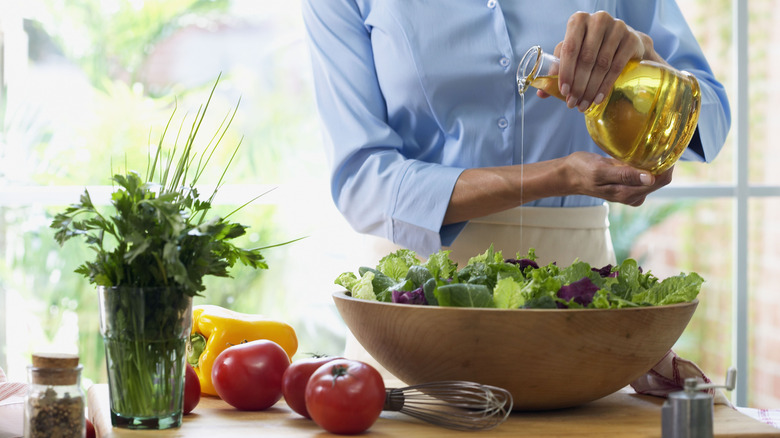Why You Should Always Add Those Heavy Salad Ingredients After Dressing
Salads can stand alone as their own meal or serve as the perfect side dish to complement a heavier recipe. We might think of lettuce when we think of a salad, but other ingredients, such as pasta, or whole grains like farro, can become the base of a delicious salad, too. Regardless of what you're using to prepare your dish, one thing remains the same: Any heavier toppings should be added after the dressing to prevent them from ending up at the bottom of the bowl.
Preparing a salad properly is an integral part of keeping it delicious; adding some things too soon and others too late can mess with the salad's flavor and texture. Plus, presentation matters, and you don't want your guests to see a big pile of greens because all of the toppings sank to the bottom when you tossed them with the dressing. Thankfully, there are easy ways to ensure your salad tastes and looks as top-notch as possible.
Avoid adding heavy toppings until after you've dressed the dish
Tossing the salad is the process of blending ingredients with salad dressing to make sure everything is coated evenly. Lighter toppings, such as thinly sliced red onion or diced tomatoes, are fine to incorporate before giving the salad a toss. But for anything heavier, such as artichoke hearts or protein, wait until after the salad is dressed. Otherwise, the tossing process could shift those heavier ingredients to the bottom of the bowl, which will impact the presentation and distribution of ingredients. Adding a layer of dressing also makes the lettuce (or pasta, or any other salad base) a little heavier, helping them hold the toppings better.
There is an exception, though: If the heavier topping is integral to helping develop the salad's flavor, you might have to add it before the dressing. While something like chicken or nuts can be added after, if you want the flavors of certain toppings (such as orange slices or any other fruit) to combine with the dressing, you might have to toss them along with the salad. If you do this, set a few pieces of the topping aside to top the salad afterward for a better presentation.
Tips for taking your salad up a notch
If you're preparing a salad with greens, avoid adding the salad dressing until you're just about to serve it. Lettuce leaves are delicate, as are other leafy vegetables like arugula or spinach, so they'll wilt easily once tossed with dressing. You can prep the toppings and measure out the salad dressing ahead of time, then add it all together just before plating.
Take into consideration the moisture level of certain toppings. Tomatoes, for example, harbor a lot of moisture, so consider that when debating how much dressing to add. Plus, if you're making pasta salad, add half of the dressing when you cook the pasta to let the flavors combine while the dish sits. Then, just before serving, add the remaining dressing to make sure the salad isn't too dry for your guests.
When deciding on toppings, choose those that balance each other. Sweet fruit slices paired with tangy blue cheese will create a perfect flavor contrast. A mayo-based salad's rich, fatty flavor can almost always be enhanced with the acidity of lemons or oranges; flavors that build and complement are always the ones that pair best.


